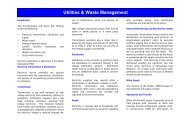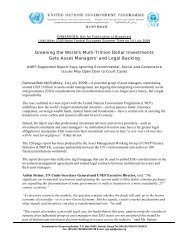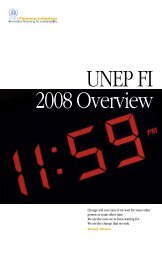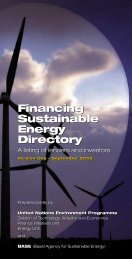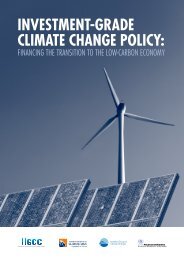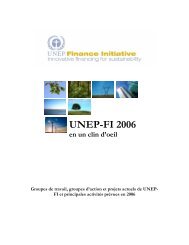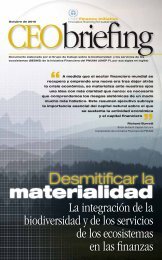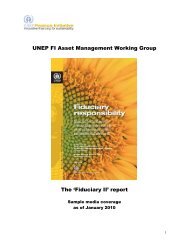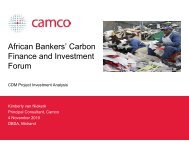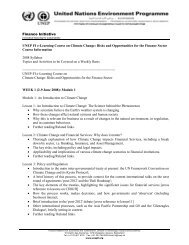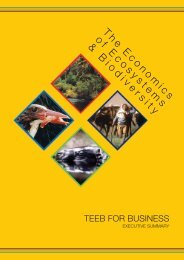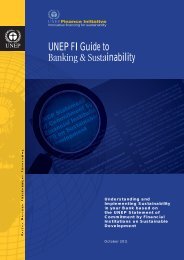Carbon 2009 Emission trading coming home - UNEP Finance Initiative
Carbon 2009 Emission trading coming home - UNEP Finance Initiative
Carbon 2009 Emission trading coming home - UNEP Finance Initiative
You also want an ePaper? Increase the reach of your titles
YUMPU automatically turns print PDFs into web optimized ePapers that Google loves.
<strong>Carbon</strong> <strong>2009</strong><br />
and limitation or exclusion of<br />
HFCs as likely changes to this<br />
flexible mechanism, but also the<br />
widespread use of benchmarks<br />
for baselines and additionality<br />
purposes is a highly rated change.<br />
Like in China, a high share of<br />
respondents in India expect<br />
that a limitation or exclusion of<br />
HFCs and a widespread use of<br />
benchmarks for baselines and<br />
additionality purposes will apply<br />
to the CDM after 2012, but the<br />
change next on the list is the<br />
limitation or exclusion of largescale<br />
hydro.<br />
HFCs and hydro<br />
have been controversial<br />
project types<br />
Both hydro- and HFC projects<br />
have been controversial project<br />
types in the CDM. Environmental<br />
groups have lead a high profile<br />
political and media campaign<br />
against hydro projects, claiming<br />
that many of these schemes<br />
harm the local environment and<br />
communities. 330 hydro projects<br />
have already been approved by<br />
the UN, with the potential to<br />
generate 135 million credits. On<br />
the other hand, HFC projects<br />
currently account for around 55<br />
percent of all certified emissions<br />
reductions (CERs) issued from<br />
CDM projects. The EU is likely to<br />
propose the production of HFC<br />
gases be eliminated in a bid to<br />
cut greenhouse gas emissions,<br />
in return for revenue to help<br />
poor countries adapt to climate<br />
change.<br />
Proposals for an increased use<br />
of benchmarks in the CDM were<br />
thrown out from the negotiations<br />
in Poznan in December 2008,<br />
due to resistance from Brazil,<br />
Figure 4.7: Time for change?<br />
“Which changes, if any, do you think will be made to the CDM from 2013 onwards?”<br />
CER project developers/aggregators. Multiple answers possible. N = 407.<br />
HFCs limited/excluded<br />
Sectoral CDM<br />
Benchmark use<br />
Large hydro limited/excluded<br />
Marine transport<br />
N2O limited/excluded<br />
CER value differentiation<br />
Other changes<br />
Source: Point <strong>Carbon</strong><br />
China and India. An increased<br />
use of benchmarks was pushed<br />
by the EU, as this would simplify<br />
methodologies. It is believed that<br />
Brazil, China and India resist this<br />
because they see it as a first step<br />
towards commitments.<br />
Among those that think sectoral<br />
CDM will be allowed in the<br />
post-2012 framework, more<br />
than 60 percent believe that<br />
cement, power and steel will<br />
be part of this expansion of the<br />
mechanism (see Figure 4.8). All<br />
Figure 4.8: Which sectors for sectoral CDM?<br />
Respondents who think that sectoral CDM will be allowed. N=22.<br />
Cement<br />
Power (electricity)<br />
Steel<br />
Aluminium<br />
Aviation<br />
Marine transport<br />
Other:<br />
None of the above<br />
Share of respondents<br />
Policy CDM<br />
REDD<br />
CCS<br />
Nuclear<br />
No changes<br />
Source: Point <strong>Carbon</strong><br />
Aviation<br />
0% 10% 20% 30% 40% 50% 60%<br />
Share of respondents<br />
0% 10% 20% 30% 40% 50% 60% 70% 80%<br />
36<br />
All rights reserved © <strong>2009</strong> Point <strong>Carbon</strong>



